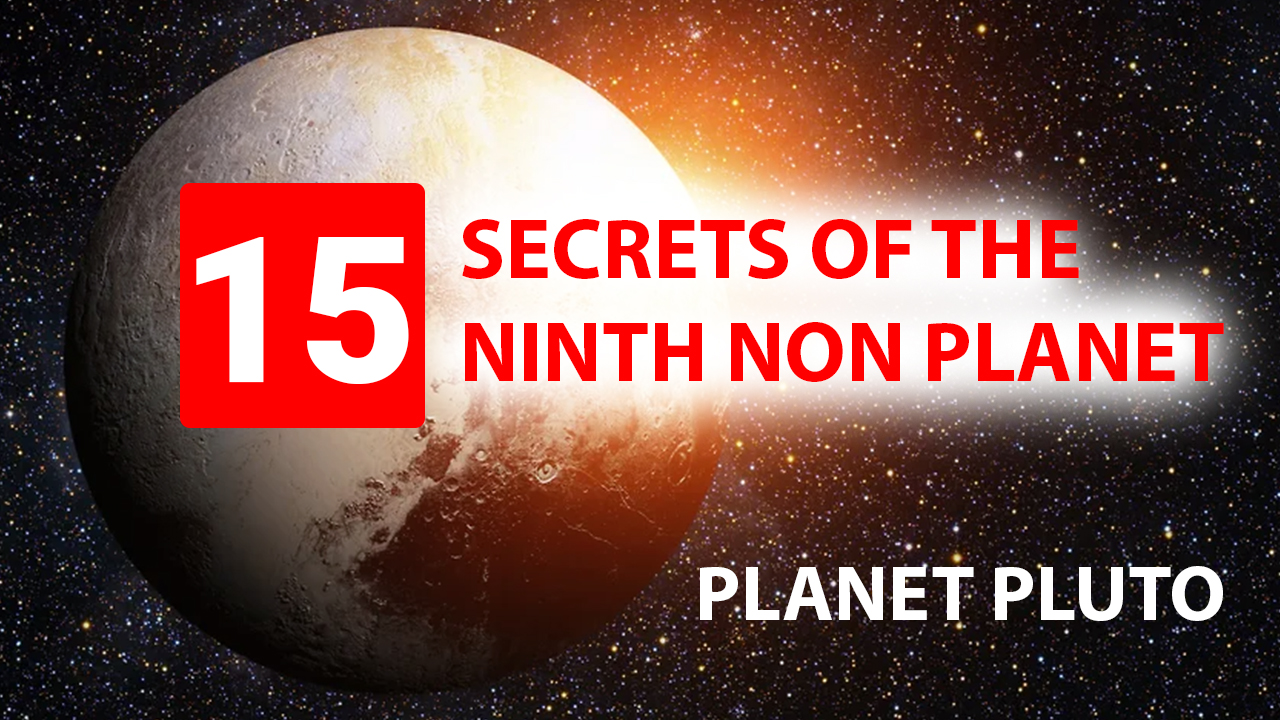On March 13, 1930, astronomer Clyde Tombaugh telegraphed Harvard College from the Lowell Observatory, one of the oldest in the United States, that he had discovered the ninth planet of the Solar System. It was named Pluto. After years of research, scientists denied the celestial body the right to be a planet. Although the controversy around this issue did not subside for a long time.
1
Pluto was discovered by mistake. The first seven planets can be observed either with the naked eye or with a telescope. Neptune became the first planet to be discovered indirectly, theoretically, on the tip of a pen. These were the 1880s. It was first predicted by the gravitational effect on neighboring Uranus, and then it was seen with a telescope. It was logical to ask the question: if the eighth planet was discovered this way, then the hypothetical ninth planet could also be detected by the gravitational disturbances of the eighth planet, Neptune? Erroneous calculations followed, which showed that Neptune’s orbit was indeed under some disturbance of an unknown celestial body, and it was even clear where to look for this body. And so Clyde Tombaugh, a student of Percival Lowell, the most famous astronomer of his time, was tasked with finding this planet. And he found it. Later it turned out that there was no gravitational influence on Neptune’s orbit, that the newly discovered planet was too small and could not disturb anything. But Clyde Tombaugh was an American, so this discovery became American pride, and Pluto – “their” planet.
2
The name Pluto appeared as a result of an open competition. The option of British schoolgirl Venetia Burney won. There is an opinion that the first two letters contributed to this choice: P. L. are the initials of Percival Lowell, Clyde Tombaugh’s teacher.
3
For a very long time, all the assumptions about Pluto remained as such. The first, weak and rough pictures of Pluto were made by the Hubble telescope. And some clarity came to scientists only in the 2010s with the flyby of the New Horizons mission. Although the status of the planet was already disputed in the 1990s.
4
Pluto does not move like a planet, but rather like an asteroid. Its orbit is very elongated. And in some places it even goes inside the orbit of Neptune, allowing Pluto to be closer to the Sun than Neptune. In addition, the planets lie in the same plane – in the plane of the ecliptic, and Pluto is at an angle to it.
5
One for all. In the 1950s, astronomer Gerard Kuiper theoretically predicted the existence of a huge belt or cloud of all kinds of objects – asteroids and comets beyond the orbit of Neptune. Comets periodically fly to Earth from there. In 1978, a satellite of almost equal size to Pluto, Charon, was discovered. Now five more small satellites of Pluto are known. The existence of the Kuiper belt was subsequently confirmed. As astronomical methods developed, starting in the 1990s, these objects began to be discovered. It turned out that there are countless such Pluto-like objects. And they are all close in size and composition, all have elongated orbits at an angle to the plane of the ecliptic. It became clear that Pluto is one body out of a large number of similar ones. Then the question arose whether it can be considered a planet based on the totality of all the oddities associated with it. In 2006, Pluto was removed from the list of planets.
6
A year on Pluto lasts about 250 Earth years. Therefore, experimental data on its seasonal variations has not yet accumulated. But calculations suggest that the atmospheric pressure between seasons can change fourfold with condensation and evaporation of a large amount of frost.
7
The temperature on Pluto is unlikely to rise above -240 °C. The Sun is so far from it that it appears as a small luminous point, slightly larger than a star in the sky. Therefore, heating on the surface of Pluto is insignificant, and the thin atmosphere does not produce a noticeable greenhouse effect.
8
An object of desire for astrobiologists. This is how Pluto and similar objects like Enceladus, a satellite of Saturn, or Europa, a satellite of Jupiter, look in the eyes of scientists who are looking for signs of life beyond Earth. The presence of liquid water greatly increases the chances of life arising and surviving. But we must understand that the water there is most likely not pure, not distilled, and not of the same composition as on Earth: it may have a very high salt content. It is not known how salty it is, but in some ways it may even contribute to the development of life. Scientists will most likely not be able to drill inside in the near future, because this ice cap is about 100 km thick – and its lower layers under gigantic pressure will have properties similar to metal. This is an impossible task with current technological capabilities. But it would be possible to conduct a more detailed analysis of the substance that came out of the depths onto the surface of Tombaugh Regio and find out what organic substances are present there. Maybe not only on the surface itself, but a little deeper, a few centimeters or meters – this would more accurately show the substance of the depths, not changed by contact with the atmosphere.
9
Pluto consists of a mixture of ice and rocky silicate rocks. Pluto also has a subsoil. Scientists have calculated the density, built gravity models and assume that it is loose and that it has water not only outside, but also inside. But this is not surprising: all objects outside the Kuiper belt have a huge amount of water in a frozen state. On Pluto, the ice is not uniform – it can be nitrogen, and the water ice we are used to, and CO-2 ice.
10
Inside Pluto, radioactive substances decay. There is internal heat accumulated since the formation of the body, plus tidal interactions, which are helped by its satellite Charon – it shakes up the subsoil inside, heating it up. And if the subsoil is heated and consists of ice, then it is no longer ice, but water. Modern models suggest the presence of an oceanic underground layer near Pluto more than a hundred kilometers thick. What is inside this ocean is unknown, but scientists assume that almost all objects with solid surfaces outside the asteroid belt have something similar.
11
An icy “heart” on the surface. Or Tombaugh Regio is ice covered with frost (mostly nitrogen), most likely formed as a result of cryotectonic processes. It is believed that Pluto has tectonics, only instead of lava, like on Earth or Venus, liquid water with impurities comes to the surface, which freezes into ice.
12
Pluto was completely made up of mysteries. At first, nothing was clear. What did Tombaugh see? A small white dot in the picture. It was possible to roughly estimate the size of this body, its distance from the Sun, but over time it became known that this body behaves very strangely. When the Hubble telescope was launched, we received very weak, rough pictures of Pluto and its satellite, just a few pixels. Clarity only appeared in the 2010s with the flyby of the New Horizons mission. And the status of the planet began to be disputed in the 1990s.
13
In 2006, the New Horizons automatic interplanetary station was sent to Pluto. The US had been promoting this mission since the 1980s. The project’s ideological leader, Alan Stern, proposed launching it jointly with the USSR, but in the end he was delayed for almost 40 years. The Americans had been to every planet except the ninth (at that time it was still the ninth planet), so it was necessary to visit there too. The AMS successfully reached its destination in 2015. The device flew close to Pluto and took spectacular and informative pictures.
14
Was it in vain that Pluto was offended? Astronomers have opened Pandora’s box, but this is inevitable. As usually happens, the more we begin to study, the more questions arise. The Hubble telescope is, of course, great, but the pictures it showed, those few pixels, are not very informative. But then the modern mission New Horizons was sent to Pluto, and the pictures instantly flew around the world and became a sensation. The icy “heart” on the surface of the planet was especially memorable. But, most importantly, an idea of the geology, geomorphology of the surface and its approximate composition appeared. It became known that Pluto has a nitrogen-methane atmosphere.
15
Pluto’s satellite Charon is smaller and similar in composition. But it has a little more ice, it is less dense. It does not have an atmosphere, at least, it has not been registered. Therefore, it is not very interesting, although even it may have a layer of liquid water, only thinner. According to the working hypothesis, Charon was not captured from the outside, but was born together with Pluto from the same “test”. There was some kind of sliding collision that led to the formation of two objects: as if in a dance, they began to circle each other together, becoming a binary system. Much the same way, according to one version, the Earth and the Moon came into being.







